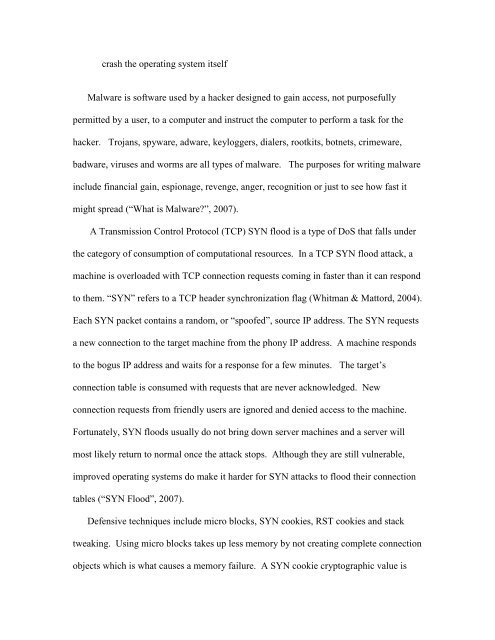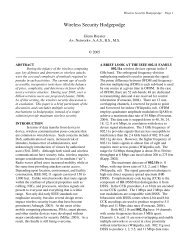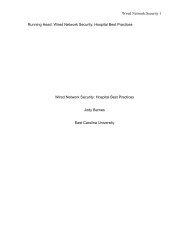Common Denial of Service Attacks - Infosecwriters.com
Common Denial of Service Attacks - Infosecwriters.com
Common Denial of Service Attacks - Infosecwriters.com
Create successful ePaper yourself
Turn your PDF publications into a flip-book with our unique Google optimized e-Paper software.
• crash the operating system itself<br />
Malware is s<strong>of</strong>tware used by a hacker designed to gain access, not purposefully<br />
permitted by a user, to a <strong>com</strong>puter and instruct the <strong>com</strong>puter to perform a task for the<br />
hacker.<br />
Trojans, spyware, adware, keyloggers, dialers, rootkits, botnets, crimeware,<br />
badware, viruses and worms are all types <strong>of</strong> malware.<br />
The purposes for writing malware<br />
include financial gain, espionage, revenge, anger, recognition or just to see how fast it<br />
might spread (“What is Malware?”, 2007).<br />
A Transmission Control Protocol (TCP) SYN flood is a type <strong>of</strong> DoS that falls under<br />
the category <strong>of</strong> consumption <strong>of</strong> <strong>com</strong>putational resources. In a TCP SYN flood attack, a<br />
machine is overloaded with TCP connection requests <strong>com</strong>ing in faster than it can respond<br />
to them. “SYN” refers to a TCP header synchronization flag (Whitman & Mattord, 2004).<br />
Each SYN packet contains a random, or “spo<strong>of</strong>ed”, source IP address. The SYN requests<br />
a new connection to the target machine from the phony IP address. A machine responds<br />
to the bogus IP address and waits for a response for a few minutes. The target’s<br />
connection table is consumed with requests that are never acknowledged. New<br />
connection requests from friendly users are ignored and denied access to the machine.<br />
Fortunately, SYN floods usually do not bring down server machines and a server will<br />
most likely return to normal once the attack stops. Although they are still vulnerable,<br />
improved operating systems do make it harder for SYN attacks to flood their connection<br />
tables (“SYN Flood”, 2007).<br />
Defensive techniques include micro blocks, SYN cookies, RST cookies and stack<br />
tweaking. Using micro blocks takes up less memory by not creating <strong>com</strong>plete connection<br />
objects which is what causes a memory failure. A SYN cookie cryptographic value is
















